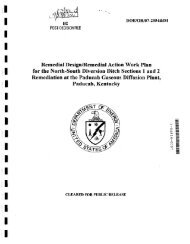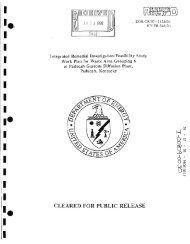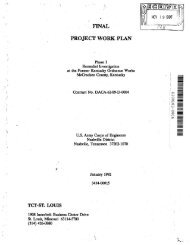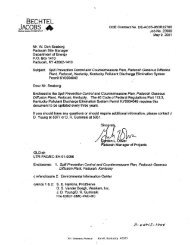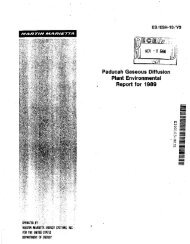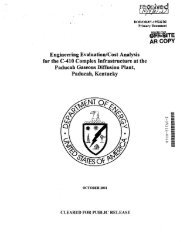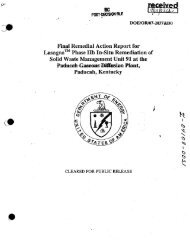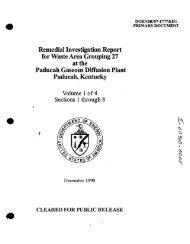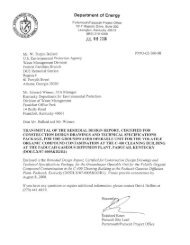1 - paducah environmental information center
1 - paducah environmental information center
1 - paducah environmental information center
You also want an ePaper? Increase the reach of your titles
YUMPU automatically turns print PDFs into web optimized ePapers that Google loves.
Annual Site Environmental Report for 1999<br />
• Completed installation and began<br />
operation of the Lasagna technology<br />
as the selected remedial alternative for<br />
reducing the concentration of TCE in<br />
SWMU 91.<br />
• Submitted the Remedial Investigation<br />
~RI)IFS Work Plan for the Surface Water<br />
Operable Unit to the regulators for<br />
review and comment.<br />
• Performed the WAG 28 and WAG 3<br />
RIs, the WAG 8 Site Evaluation (SE),<br />
and the Data Gaps Investigation.<br />
Information concerning these four<br />
activities is summarized in the following<br />
text.<br />
Lasagna<br />
In July 1998, DOE issued the Record of<br />
Decision for Remedial Action at Solid Waste<br />
Management Unit 91 of Waste Area Group 27 at<br />
the Paducah Gaseous Diffusion Plant, Paducah,<br />
Kentucky (DOE 1998). The Record of Decision<br />
(ROD) designated Lasagna as the selected<br />
remedial alternative for reducing the<br />
concentration of TCE in SWMU 91 to levels that<br />
would decrease the potential groundwater risk to<br />
human health and the environment at the pointof-exposure<br />
(POE).<br />
Lasagna was selected as the preferred<br />
remedial alternative for the reduction of TCE in<br />
the soil at SWMU 91. The ROD states, ''The<br />
primary objective of this remedial action is to<br />
reduce the level of TeE-contaminated soil,<br />
thereby reducing the potential future<br />
concentrations in groundwater that could pose a<br />
threat to human health and the environment' at<br />
the POE (ii.e.,. theJ!)OE property boundary)."<br />
The Lasagnasystem willibe operated for two<br />
years in an,attempt to reduce the concentration of<br />
TCE in SWMU 911 soil from an average of84 mg!<br />
kg to an average of less than 5.6 mgtkg. If after<br />
two years the regulatory approved cleanup level<br />
of 5.6 mglkg has not b,eenachieved, the system<br />
may operate an additional 12 months to achieve<br />
the cleanup levels.<br />
Lasagna uses an applied direct current<br />
electric field to drive TCE-contaminated<br />
groundwater through treatment zones installed<br />
in the contaminated soil. This induced<br />
groundwater flow is called electro-osmosis. The<br />
groundwater flow induced by the direct current<br />
travels from the anode electrodes to the cathode<br />
electrode. Groundwater containing TCE is<br />
driven away from anode electrodes toward the<br />
cathode electrode and' passes through a series of<br />
iron particle treatment zones installed between<br />
them. The TCE is broken down into<br />
nonhazardous compounds as it comes in contact<br />
with the iron particles in the treatment zones.<br />
Additional <strong>information</strong> about the Lasagna<br />
technology and its development can be found in<br />
the Final Soil Characterization Work Plan For<br />
The Paducah Gaseous Diffusion Plant Lasagna<br />
Pilot Test In The Cylinder Drop Test Area<br />
(MMES 1994) and the DNAPL Site<br />
Characterization And Lasagna Technology<br />
Demonstration At Solid Waste Management Unit<br />
91 Of The Paducah Gaseous Diffusion Plant;<br />
Kentucky (LMES 1996a).<br />
Anode electrode zones were installed<br />
generally north to south along the outer edges of<br />
the 90-ft wide treatment area. The cathode<br />
electrode zones were installed generally north to<br />
south in the middle of the treatment area. The<br />
direct current to energize the electrodes comes<br />
from a rectifier that is fed from a 480-volt<br />
alternating current supply constructed for this<br />
project. New overhead electrical utility lines,<br />
power transformers, electrical switching <strong>center</strong>,<br />
and associated accessories provide power to the<br />
Lasagna site. In general, treatment zones were<br />
installed at 5-ft intervals across the treatment<br />
area. However, treatment zones were installed at<br />
25-ft intervals in higher concentration regions<br />
of the treatment area~ When possible, electrode<br />
and ,treatment zones were installed to a depth of<br />
45 ft. iPlumbing was installed to recycle treated<br />
water from the cathode back to the anodes.<br />
Installation of the Lasagna technology<br />
was completed in September 1999. The system<br />
is currently operational and is being monitoring<br />
for progress of remediation of SWMU 91.<br />
Environmental Program Information<br />
3-7



